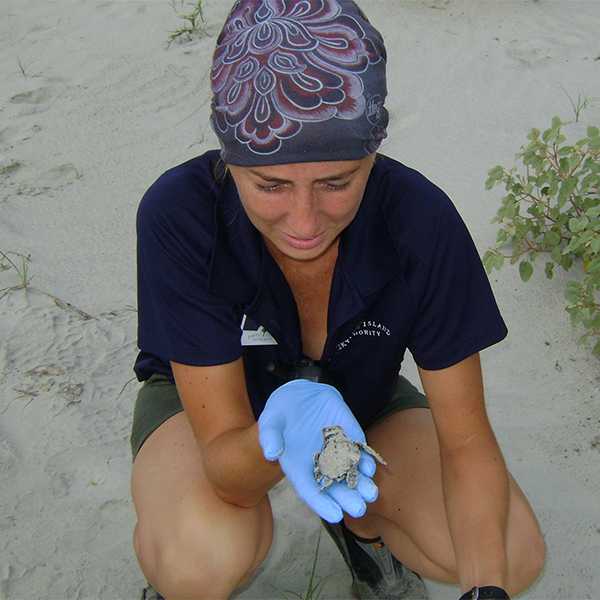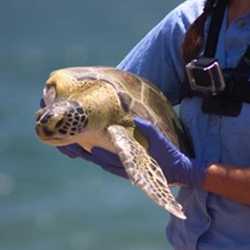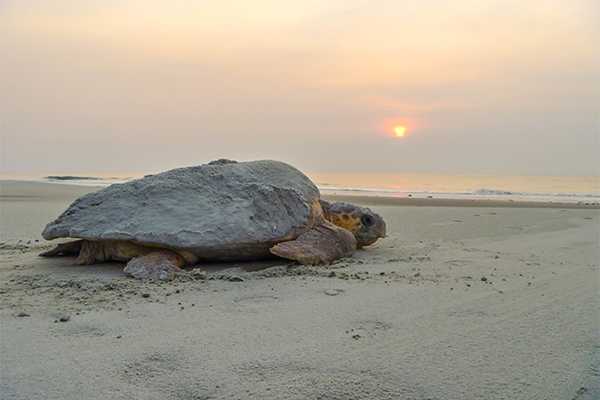Tracking the Mysterious Sea Turtle
As the sun rises over the Atlantic Ocean, two women in their mid-20s head to the beach on Jekyll Island, GA, to begin inspecting 157 loggerhead sea turtle nests sprinkled along 10 miles of the coast. They drive their all-terrain vehicle past snowy egrets and seagulls, as saltwater laps the sand. They quickly navigate the route on Driftwood Beach before high tide covers up the pathway.
Beach patrol is a daily summer ritual for Katrina, a Georgia Sea Turtle Center AmeriCorps research member, and Nicole, an intern from College of Coastal Georgia. The two run from one nest to the next, making sure they are intact, haven’t been washed over by the tide, and remain safe from predators like raccoons, ghost crabs, and fire ants, which eat turtle eggs.
A female loggerhead does not return to the nest after she comes on shore to lay her eggs. “There’s no pre-birth care,” jokes Nicole, a biological sciences major with an emphasis on coastal ecology. “We’re their moms,” adds Katrina, who earned her undergraduate degree in wildlife conservation. While one of the young women checks nests, the other records the data in a notebook.
Each time she nests, a sea turtle lays about 120 eggs. Out of all the sea turtle eggs laid, about 75% will hatch. Of those hatchlings, only one out of every 1,000 will survive to adulthood. Nicole and Katrina’s work helps increase the odds of survival.
Learning Is a Fun Egg-Sperience

Sea turtle hatchling on Jekyll Island, Georgia.
(Photo courtesy of Ronda Robinson)
The Georgia Sea Turtle Center opened in 2007 to increase public awareness through sea turtle education, rehabilitation, and research programs. In addition to offering an interactive exhibit gallery and sea turtle hospital, where guests can view many of the animal patients, the center provides outdoor learning adventures. During the summer, visitors can sign up for evening turtle walks to watch females crawl ashore from the ocean to lay their eggs, as well as dawn beach patrols to make sure the nests are secure.
Children also learn about wildlife and conservation at Sea Turtle Summer Camp. They explore the diverse habitats of Jekyll Island, from beaches and forests to ponds and marshlands, to research the many turtle species found in Georgia.
The center offers special scout programs in which boys and girls can learn about sea turtles and conservation while meeting some of their badge requirements.
Georgia Sea Turtle Center Education Associate Kira Stearns remembers a visit as a youth that sparked her own passion for the mystical animals. She calls it her turtle epiphany. “I’ve been stuck on turtles since I was a kid. When I was about 14 and was at the New England Aquarium in Boston, I saw a sea turtle come up to breathe. The turtle seemed to follow me as I walked around its tank,” she recalls.
Adoptive Parents Bond with Turtles
Stearns muses about the mystery of turtles that captures people’s hearts. Thousands of visitors from around the world visit the Georgia Sea Turtle Center each year. In addition, thousands of individuals, families, teachers, and groups “adopt” sea turtles in the hospital by giving money to support their rehabilitation.
“They’re cute, they’re charismatic,” Stearns says. “They have a certain look that draws people in, with their big shells and scaly heads. I find them peaceful to watch. They’re so graceful and strong, and can swim so fast in the water.”
Katrina, the sea turtle biologist on morning beach patrol, agrees. “Sea turtles are one of those animals people just like,” she says. “They’ve been to the depths of the ocean. They’re so old.”
Big Bertha, approximately 90 years old, holds the record for longevity among sea turtles that have nested at Jekyll Island. Her granddaughter also has come ashore there to lay her eggs. Biologists know their ages because sea turtles on Jekyll Island are tagged before returning to the ocean.
Both women enjoy watching guests connect with the magical animals. “Our Adopt-A-Sea Turtle program has exploded. It carries the conservation message even further,” reports Stearns. For a $50 donation to the Georgia Sea Turtle Center, adoptive parents receive photos, fact sheets, letters, and e-mail updates about their animal’s rehabilitation progress and notice of its potential date of release back to the ocean.

After rehabilitation, Mahi prepares to return to the sea.
(Photo courtesy of Georgia Sea Turtle Center)
A juvenile green sea turtle named Mahi, released in July 2015 in the St. Augustine, FL, region where it was found, drew several hundred witnesses from across the Eastern United States. The well-connected turtle had more than 1,200 adoptive parents. Before Mahi’s release, the rehabilitation team carried the turtle around to say goodbye to its supporters, who had traveled to the beach for the occasion.
Discovered by a hiker in St. Johns County, FL, in January 2013, Mahi was tangled in fishing line around the leg of a picnic table. The extensive damage caused by the line wrapped around the front right flipper, along with ingestion of the fishing filament, made the odds of survival small. Mahi was rushed to the Georgia Sea Turtle Center, where veterinarian and director Dr. Terry Norton performed emergency surgery to remove the fishing line inside the stomach. The next day, he amputated Mahi’s right front flipper. Five days after the surgery, Mahi was able to swim in a deeper tank and began to eat again.
Financial support from adoptive parents made Mahi’s treatment and follow-up care possible. And, as Norton says, “It fulfills a psychological need to care for an animal.”
The wildlife veterinarian was particularly touched by a 4-year-old turtle lover named Silas, who had terminal liver cancer and a passion for sea turtles. During his cancer treatments, Silas watched the children’s show “Go Diego Go” about sea turtles and fell under the spell of the ancient creatures. He covered his bedroom in sea turtle stuffed animals. He and his family visited the Georgia Sea Turtle Center, where a juvenile loggerhead sea turtle was named in his honor. Silas lived long enough to see his turtle released on Tybee Island, GA, in April 2013.
Enjoy Turtles in the Wild, Not As Pets
Even though sea turtle centers provide a close look at the engaging wild reptiles, Norton urges people to think twice about turtles as pets. “We hear anecdotes about people finding a turtle in their backyard and taking it in to care for it,” the veterinarian says. “Removing a species from its natural habitat can be detrimental. They have specific needs to maintain their health.”
He adds, “Box turtles and pond turtles may live for 20+ years. It is a long-term commitment for any pet owner.” Norton believes local pet stores generally are not a good place to buy turtles—even though the reptiles look small and easy to take care of. “Most of these animals will get relatively big, compared to what they are when they’re cute little babies.”

Mission accomplished! With her eggs laid, the turtle heads back home to the ocean.
(Photo courtesy of Georgia Sea Turtle Center)
In addition, small turtles can make people very ill. Turtles can carry bacteria called Salmonella without showing any symptoms, but can cause serious or life-threatening infections in humans, especially children. For that reason, Norton advises people who do have pet turtles to wash their hands carefully. Don’t clean turtle supplies, such as a cage or bowl, in the kitchen sink or where the family eats meals. “It’s really all about good hygiene: washing hands and keeping things separate.”
The veterinarian wants people to enjoy the mystery of sea turtles—at a respectful distance. “You can see this prehistoric animal that lived with dinosaurs, coming out of the water just to nest. You see huge, 300-pound creatures emerge from the water, lay their eggs, cover their eggs, and then disappear. Then hatchlings often come back to the same island where they were hatched.”
The sightings are a privilege. “I would want my kids or my grandchildren to have that experience I’ve had to see these animals in the wild,” says Norton.
- Page last reviewed: February 8, 2017
- Page last updated: February 8, 2017
- Content source:


 ShareCompartir
ShareCompartir